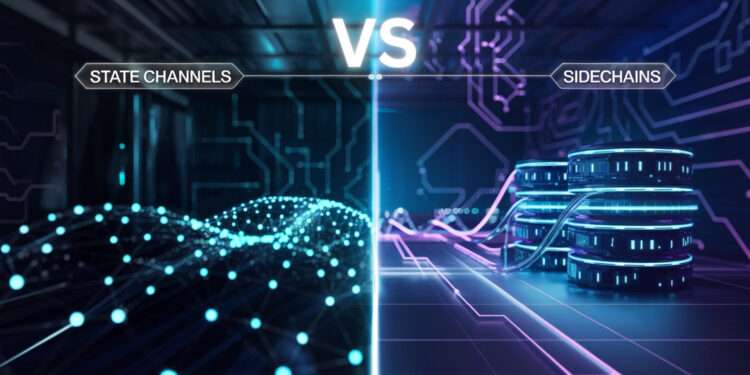Imagine waiting hours for a simple coffee purchase to go through, and paying a huge fee on top of it. This is the reality for some blockchain users today. The blockchain scaling problem makes it hard to use and grow. State channels and sidechains are two options that provide solutions. Both are meant to speed up blockchains, but work in different ways. One might suit you better based on what you need.
Understanding Blockchain Scaling Challenges
The “scaling problem” refers to the limit on how many transactions a blockchain can handle. Blockchains struggle with how fast transactions occur, how big blocks are, and how long confirmations take. These limitations slow things down a lot.
The Bottleneck Problem
Think of a blockchain as a highway. If the highway has a small number of lanes (block size), only a few cars (transactions) can pass at once. The time it takes for the light to turn green (block time) also affects traffic. Smaller blocks and long block times limit how much the blockchain can do. There’s a trade-off between security, staying decentralized, and scaling up, called the scalability trilemma.
Impact on User Experience and Adoption
Slow transactions and high fees frustrate people. This prevents folks from using blockchain more often. For example, DeFi (decentralized finance) apps can get expensive during busy times. Micropayments, like paying a tiny amount for an article, become impossible if fees are too high. All of these problems limit blockchain’s usefulness in the real world.
What are State Channels?
State channels are a way to do transactions off the main blockchain. They let folks make many transactions without clogging the main chain. Then, only the final results get recorded on the blockchain.
How State Channels Work: A Step-by-Step Explanation
Imagine a bar tab. You open a tab (open a channel) with the bartender. Throughout the night, you order drinks (do transactions). The bartender keeps a running total. At the end of the night, you pay the tab (close the channel) and that final amount gets recorded.
Here’s how it works on a blockchain:
- Open: Two parties lock funds in a smart contract on the main chain.
- Transact: They exchange transactions directly, updating the “state” without involving the main chain.
- Close: The final state is submitted to the main chain, and funds are distributed.
Use Cases for State Channels
State channels work well in specific situations. Micropayments are a great use. Think streaming services or apps that charge per use. Gaming also benefits. Fast in-game purchases need quick transactions. Payment channels, like the Lightning Network on Bitcoin, is a real-world example.
Exploring Sidechains as a Scaling Solution
Sidechains are separate blockchains that connect to the main one. They can do their own thing but still work with the main chain’s assets.
How Sidechains Work: A Deep Dive
A two-way peg lets you move assets between the main chain and the sidechain. It’s like exchanging money at a border. You “lock” your coins on the main chain, and get the same amount on the sidechain. Sidechains can use different ways to agree on transactions (consensus mechanisms). They don’t have to follow the main chain’s rules.
Use Cases for Sidechains
Sidechains have different uses too. Companies use permissioned sidechains for their own needs. Folks can test new features on sidechains before putting them on the main chain. Managing certain assets, like security tokens, is easier with sidechains made for that purpose.
State Channels vs. Sidechains: A Detailed Comparison
Both state channels and sidechains help scale blockchains. But they take different approaches.
Security Considerations
State channels get their security from the main chain. If something goes wrong, the main chain protects the funds. Sidechains have their own security, which might be stronger or weaker. You need to trust the sidechain’s security.
Throughput and Transaction Costs
State channels are super fast and cheap inside the channel. Sidechains can handle more transactions than the main chain, but costs vary. It depends on how the sidechain is designed.
Decentralization and Control
State channels keep the decentralization of the main chain. Sidechains can be more centralized. It depends on how they’re run. Some sidechains might have a few companies in charge.
Complexity and Implementation
State channels need careful planning of smart contracts. Sidechains need more work to set up and run. They need their own infrastructure.
Choosing the Right Solution: A Decision-Making Framework
How do you pick between state channels and sidechains? It comes down to what you need.
Factors to Consider
Think about these things:
- How secure does it need to be?
- How many transactions will there be?
- Does it need to be decentralized?
- How much money is there for development?
Tips for Choosing
Here are some tips to decide:
- If security and staying decentralized is vital, state channels might be better.
- If you need a lot of transactions and want to try new things, sidechains could work.
- For micropayments and fast interactions, state channels are often a good fit.
- If a business wants its own blockchain, sidechains can give the control it needs.
Conclusion
State channels and sidechains both tackle the blockchain scaling problem. State channels offer fast, secure transactions for specific interactions, while sidechains provide more flexibility. There is no one-size-fits-all answer. Understanding the ups and downs of each helps build a blockchain ecosystem that will last.

























